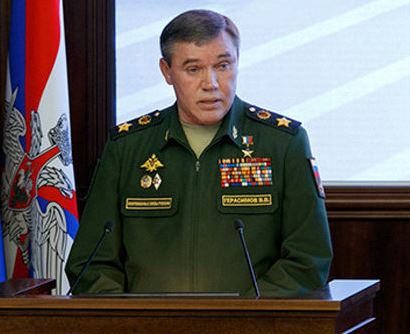Let’s round out what Russian General Staff Chief Valeriy Gerasimov said on March 24. Though the conference was held at the Military Academy of the General Staff, Gerasimov was actually addressing a plenary of the Russian Academy of Military Sciences.
The Academy is technically non-governmental, but more accurately quasi-official. It counts many senior Russian military officers, scientists, and researchers (and even more retired ones) in its membership. It’s an august unofficial think tank for the MOD.
One can be sure of a couple of things.
First, Gerasimov’s remarks would have differed had he spoken to a strictly MOD audience. But the General Staff likely shares most of its thinking about modern war with the Academy of Military Sciences. Second, it’s unlikely KZ covered every aspect of what Gerasimov said. Some portions probably weren’t reported. One wonders what the entire, unfiltered speech sounded like.
At any rate, Gerasimov had this to say about Russia’s involvement in Syria:
“Before Russia entered the conflict on the government’s side, this country actually conducted an undeclared war for the right to exist for more than four years. There’s no clear answer when this struggle transformed from internal disorder into military conflict. No state openly declared war on Syria, but all illegal armed formations are armed, financed and controlled from abroad. With time the list of participants in the military conflicts there is broadening. Together with regular troops, the internal protest potential of the population is active, as are terrorist and extremist formations.”
“Today independent military specialists see the military conflict in Syria as the prototype of a ‘new generation war.’ Its main feature is the fact that Syria’s state-enemies conduct covert, undetectable actions against it, without being dragged into direct military conflict.”
Then KZ paraphrases Gerasimov:
“The changing character of armed struggle is a continuous process, and all previous military conflicts substantially differ from one another. The content of military actions itself is changing. Their spatial scale is growing, their tension and dynamism are increasing. The time parameters for preparing and conducting operations is being reduced.”
“A transition from sequential and concentrated actions to continuous and distributed ones, conducted simultaneously in all spheres of confrontation, and also in distant theaters of military operations is occurring.”
The MOD daily quotes him again:
“The requirements for troop mobility are becoming more severe. The transition to systematic destruction of the enemy on the basis of integrating the forces of all strike and fire means into a single system is occurring. The role of electronic warfare, information-technical and information-psychological actions is increasing. The growth in the share of precision weapons supports pinpoint and selective target destruction, including critically important ones, in real time.”
On the growing size of theaters of military operations:
“They encompass areas with installations of military and economic potential located at a significant distance from the zone of immediate military actions. The scale of employing remotely-controlled robotic strike systems is growing. In a complicated, rapidly-changing situation, the capability to control troops and forces effectively is acquiring special importance.”
This is when Gerasimov said every conflict has its own features and talked about targeting the enemy’s economy, C3, reconnaissance, and navigation systems.
He said:
“The organization development and training of the RF Armed Forces is being realized accounting for these tendencies in the changing character of armed struggle.”
KZ paraphrases the General Staff Chief’s words about balanced development of the armed services and the provision of modern weapons. Reserves and the VDV — with their new tank, EW, and UAV capabilities — will reinforce troop groupings in strategic directions. Here Gerasimov also mentioned the extension of air and fleet deployment areas — including to the Arctic. Then Gerasimov described groupings of cruise missile launchers established in all strategic directions, reducing the time to fire them, and developing unmanned reconnaissance-strike systems.
According to KZ’s account, Gerasimov referenced President Vladimir Putin’s March 1 description of Russia’s future strategic weapons. He said new missiles and other weapons — including hypersonic ones and those “without foreign analogues” — will have increased capability to overcome U.S. missile defenses. He ended with his statement that new precision systems — including hypersonic missiles — will allow for non-nuclear strategic deterrence.
It’s quite a vision of the Russian military and what it needs to do in the future. It sounds like it describes the situation in a military already at war. But Gerasimov and his troops have a way to go to achieve all of this.
One senses in the General Staff Chief’s comments a reaction to Russia’s recent participation in old-school kinetic conflicts (albeit with the use of modern ground-, sea-, and air-launched missiles) in Ukraine and Syria. It could be a call to develop Russia’s command and control warfare capabilities.
Finally, it’s possible to hear the lingering echo of Soviet Marshal Nikolay Ogarkov’s words from 34 years ago:
“. . . rapid changes in the development of conventional means of destruction and the emergence in the developed countries of automated reconnaissance-strike systems, long-range precision terminally-guided combat systems, unmanned aerial vehicles, and qualitatively new electronic control systems make many types of weapons global and make it possible to increase sharply (by at least an order of magnitude) the destructive potential of conventional weapons, bringing them closer, so to speak, to weapons of mass destruction in terms of effectiveness. The sharply increased range of conventional weapons makes it possible immediately to extend active combat operations not just to border regions, but to the whole country’s territory, which was not possible in past wars. This qualitative leap in the development of conventional means of destruction will inevitably entail a change in the nature of the preparation and conduct of operations, which will in turn predetermine the possibility of conducting military operations using conventional systems in qualitatively new, incomparably more destructive forms than before.”

